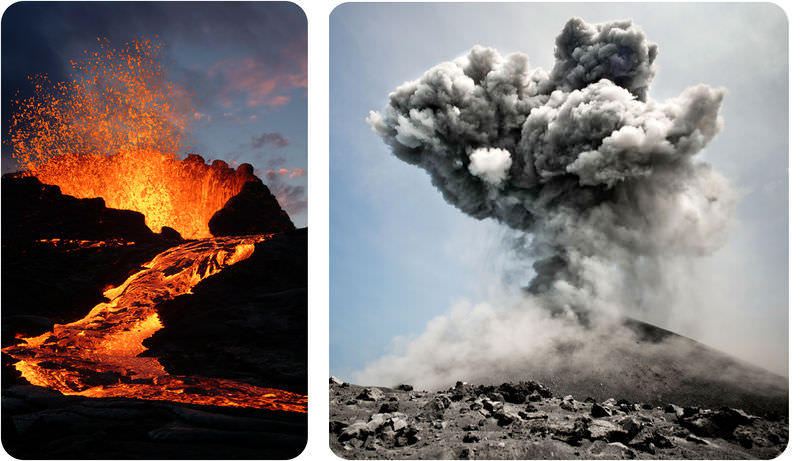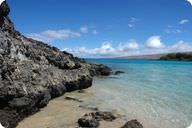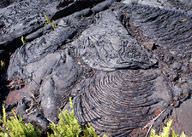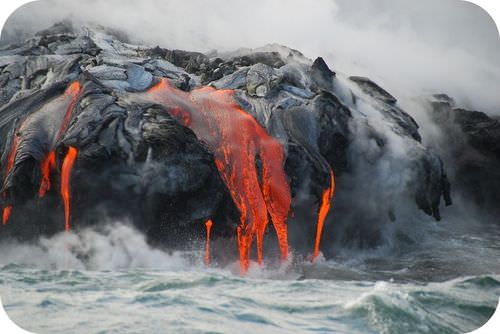7.4: Magma Composition
- Page ID
- 5428
Are all volcanic eruptions alike?
The type of eruption a volcano has depends on the type of magma in its chamber. Some eruptions are explosive. Some eruptions are quiet. All eruptions are amazing!
Magma
Magma forms deep beneath the Earth’s surface. Rock melts below the surface under tremendous pressure and high temperatures. Molten rock flows like taffy or hot wax. Most magmas are formed at temperatures between 600oC and 1300oC (Figure below).
Magma beneath a volcano erupts onto the volcano’s surface. This image is of a magma chamber underlying Yellowstone.
Magma collects in magma chambers beneath Earth’s surface. Magma chambers are located where the heat and pressure are great enough to melt rock. These locations are at divergent or convergent plate boundaries or at hotpots.
The chemistry of a magma determines the type of igneous rock it forms. The chemistry also determines how the magma moves. The higher the amount of silica in the magma, the higher the viscosity. Viscosity is a liquid's resistance to flow. Viscous magmas tend to stay below the surface or erupt explosively. These are felsic magmas, which are high in silica. When magma is fluid and runny, it is not viscous. This magma often reaches the surface by flowing out in rivers of lava. These are low-silica mafic magmas.
Lava
The way lava flows depends on what it is made of. Thick lava doesn’t flow easily. It may block the vent of a volcano. If the lava traps a lot of gas, the pressure builds up. After the pressure becomes greater and greater, the volcano finally explodes. Ash and pyroclasts shoot up into the air. Pumice, with small holes in solid rock, shows where gas bubbles were when the rock was still molten.
Fluid lava flows down mountainsides. The rock that the flow becomes depends on which type of lava it is and where it cools. The three types of flows are a’a, pāhoehoe, and pillow lava.
- A’a lava is the thickest of the non-explosive lavas. A'a forms a thick and brittle crust, which is torn into rough, rubbly pieces. The solidified surface is angular, jagged, and sharp (Figure below). A'a can spread over large areas as the lava continues to flow underneath.
A'a flows can be found in Hawaii and are much sharper and more jagged than pāhoehoe.
- Pāhoehoe lava is thinner than a'a and flows more readily. Its surface looks more wrinkly and smooth. Pāhoehoe lava flows in a series of lobes that form strange, twisted shapes and natural rock sculptures (Figure below). Pāhoehoe lava can form lava tubes. The outer layer of the lava flow cools and solidifies. The inner part of the flow remains fluid. The fluid lava flows through and leaves behind a tube.
Ropy pahoehoe flows are common on Kilauea Volcano in Hawaii.
- Pillow lava is created from lava that enters the water. The volcanic vent may be underwater. The lava may flow over land and enter the water (Figure below). Once in the water, the lava cools very quickly. The lava forms round rocks that resemble pillows. Pillow lava is particularly common along mid-ocean ridges.
Lava erupting in the water can form bulbous, pillowy forms.
Summary
- Magmas differ in composition, which affects viscosity. Magma composition has a large effect on how a volcano erupts.
- Felsic lavas are more viscous and erupt explosively or do not erupt. Mafic lavas are less viscous and erupt effusively.
- Different lava types create different rock types, such as pahoehoe and a'a. Lavas that cool underwater become pillow lavas.
Review
- What is the role of a magma chamber in a volcanic eruption?
- How is magma composition related to viscosity?
- Compare and contrast a'a, pahoehoe, and pillow lavas.






